Retailers face a major challenge when it comes to understanding the impact of their various retail advertising efforts. With multiple channels and interactions to consider, it can be difficult to accurately determine which ads are truly driving customer conversions and contributing to the bottom line. This lack of clarity can result in inefficient ad spend and missed growth opportunities. Ad Attribution is the solution to this problem, providing retailers with a comprehensive way to track and analyze conversions from specific ads.
With ad attribution, retailers can optimize their advertising efforts, improve return on investment, and drive sustainable business growth. It’s an essential tool for any retailer looking to gain insights into the effectiveness of their marketing campaigns and make every dollar count towards business success.
What is Ad Attribution?
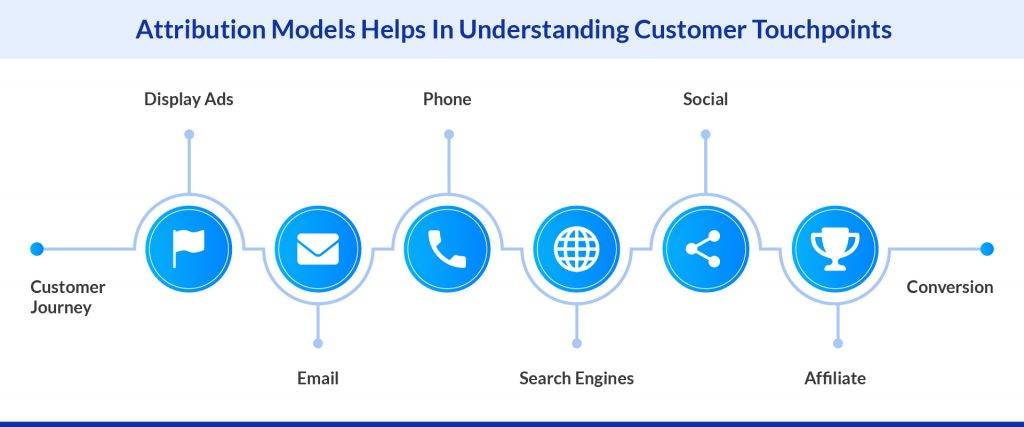
Ad attribution is a crucial process for retailers to understand the customer’s journey. By analyzing user actions from the initial ad click to the final conversion, such as signing up or making a purchase, retailers can assess the success of their marketing efforts and make informed decisions about which channels to prioritize. This not only helps maximize profits but also improves overall marketing strategies. With advanced tools and techniques, attribution allows retailers to track leads and identify opportunities and identify opportunities for desired outcome.
The attribution process involves identifying and evaluating all touchpoints in a consumer’s journey toward completing an advertiser or marketer’s goal. This includes interactions such as viewing an ad, visiting a website, or physically entering a store. The goal is to gain a thorough understanding of which touchpoints are driving conversions and which ones are not, enabling strategic improvements and optimizations in advertising campaigns.
With the emergence of multi-channel marketing, attribution has become an essential practice for retailers. By tracking and analyzing the value of different touchpoints and channels, retailers can determine the effectiveness of marketing campaigns in attracting customers and driving sales. This information guides resource allocation for maximum impact.
There are many attribution models, each offering a unique predictive or analytical framework to suit different marketing scenarios (more on this below). These models help retailers navigate customer interactions and optimize their marketing efforts, ultimately leading to sustainable business growth.
Additional Reads: How Functional Retail Media Platforms Are Built Different From Agency Ad Tools
Why is attribution difficult in marketing?
As discussed earlier, marketing attribution models are an essential piece in evaluating the success of your marketing strategies. It involves tracing and identifying the touchpoints that drive conversions. However, achieving accurate attribution can be a complicated and challenging process due to inconsistencies in attribution models.
Various tools and platforms use different models, such as first-touch (also known as first click attribution model) and last-touch attribution (or last click), which can lead to differing insights on customer journeys and lead origins. While these models offer valuable data, they may not capture the entire customer journey, making it difficult for marketers to fully understand their audience.
Marketers have access to a wealth of data, such as the Cost Per Click (CPC) of a specific ad campaign, the conversion rate of a post-click landing page in Instapage, and the lead-to-sale conversion rate in Salesforce. However, without proper integration and communication between these tools, it can create a disjointed view of the customer journey. This lack of seamless data sharing creates an incomplete understanding and fragmented view of conversions throughout the funnel. Siloed tools prevent marketers from accurately attributing conversions and optimizing their strategies for maximum success.
Addressing challenges and improving marketing attribution requires integrated solutions. These solutions ensure smooth data flow and communication throughout the entire marketing funnel. Utilizing advanced attribution models that consider multiple touchpoints, marketers can gain a more accurate understanding of the customer journey. This empowers them to make better informed decisions, optimize their marketing efforts strategically, and ultimately achieve a higher ROI on marketing spend.
Additional Read: What Is Addressable Advertising And Why Is It Important?
Types of Marketing Attribution
Single touch attribution
Single-touch attribution models are an effective way for businesses to understand which channels have the greatest impact on the number of conversions. This model assigns credit to a single touchpoint that played a role in a sale, giving companies insight into the most successful methods for driving customer engagement.
By using this approach, marketers can better focus their efforts and allocate resources toward the channels that produce the best results. This ultimately leads to more efficient and profitable marketing strategies.
While this model may have its strengths, it fails to take into account any additional interactions a customer may have with a product or brand. It also does not provide insights into how user behavior may change over time.
2 types of Single-touch attribution:
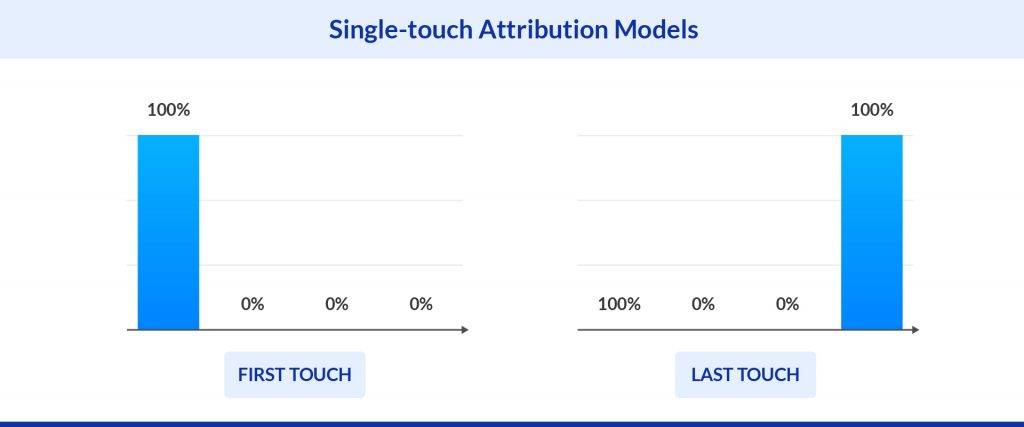
First touch attribution
The first-touch model is a helpful tool for companies looking to target their campaigns and understand the most effective channels in their customers’ journey. By identifying the initial touchpoint that exposes customers to the brand, businesses can allocate resources more efficiently and better understand their customer’s decision-making process. This can lead to more successful marketing strategies and a better overall understanding of customer behavior for businesses.
Imagine a customer’s journey that begins with clicking on a Facebook ad, followed by reading a blog post, signing up for the newsletter, and making a purchase through an email link. With the first-touch attribution model, the Facebook ad receives 100% of the credit for the conversion as it was the initial touchpoint in the customer’s journey. This valuable insight can help businesses understand and prioritize their top-of-funnel marketing efforts to attract new customers more effectively.
Using this model, businesses can gain valuable insights into how their customers interact with different content pieces and improve their customer journeys. However, it does not take into account the impact of later touchpoints in the journey, potentially leading to an incomplete understanding of the most effective methods for attracting and retaining customers.
Last touch attribution
The last-touch model is a fundamental tool for understanding customer behavior and decision-making. It examines how the customer’s final interaction with a brand, product, or service influenced their conversion. This makes it an invaluable resource for marketers looking to accurately assign credit and optimize their strategies. Additionally, its simplicity and familiarity make it easily accessible to all marketers.
For example, if a customer discovers a product through an organic search, clicks on a retargeting ad, visits the product page, and ultimately makes a purchase after clicking on a promotional email, the email would receive 100% of the credit for driving that sale. This data is crucial for marketers looking to improve their bottom-funnel strategies and allocate more resources to channels that drive conversions effectively.
There are several versions of last-touch attribution, including the last non-direct touch attribution. This method takes into account that most people don’t directly type in a website’s URL to convert. Instead, they may have visited a post-click landing page and abandoned it before returning later to claim an offer. With this type of attribution, analytics tools will track the last touchpoint before conversion, even if it wasn’t directly typed in by the prospect.
However, relying solely on this attribution model may not accurately reflect the length of time a user spent interacting with each campaign, potentially limiting its effectiveness as an ad attribution tool.
Multi-touch attribution model
The multi-touch attribution model is an advanced marketing strategy that accurately provides credits across multiple marketing touchpoints. It takes into consideration various factors, including the number of interactions with a campaign, the channels used, and the time between each touchpoint. This allows businesses to gain insight into the effectiveness of their messaging over different periods. Furthermore, this attribution model provides flexibility in allocating credit based on their specific needs, giving valuable insights into which campaigns are most successful and leading to higher returns from digital marketing efforts.
Linear attribution
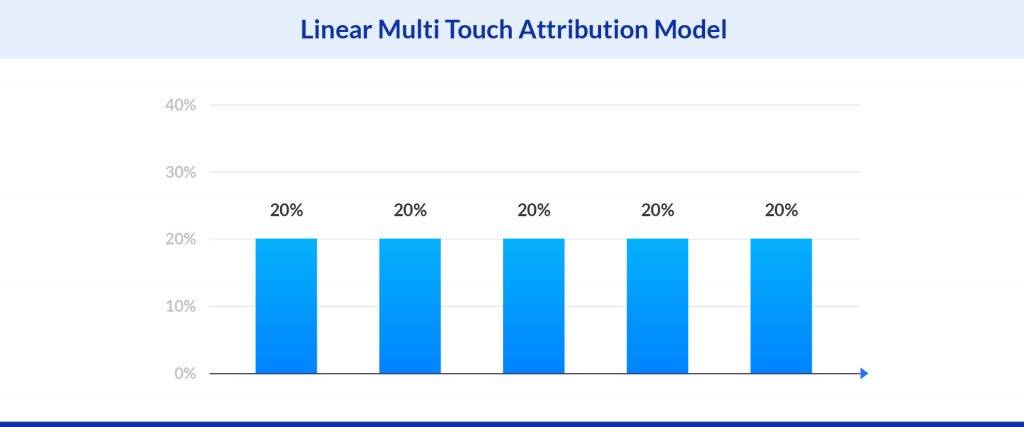
Linear attribution is a foundational model in the world of multi-touch attribution. It distributes equal credit across all touchpoints in a customer’s journey, from social media engagement to ad impressions. This allows for a holistic view of the customer journey and helps businesses understand the role of each channel in the conversion process. Its simplicity and comprehensive coverage make it a popular choice among marketers looking to identify active touchpoints and improve their understanding of the customer decision-making process.
The linear attribution model may not accurately reflect the true impact and significance of each touchpoint in a customer’s journey. While it can provide a broad overview, it may not consider long-term engagement or influence from subsequent touchpoints. This lack of depth could lead to a limited understanding of which channels are truly driving conversions. However, the model is still essential for gaining insights into the entirety of a customer’s journey and ensuring no touchpoint is left unaccounted for, providing valuable information for businesses.
Time decay attribution
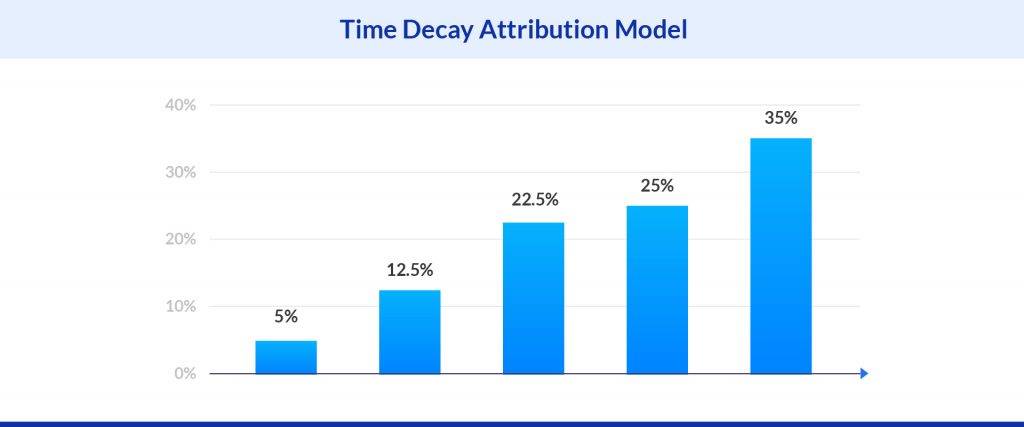
The time decay attribution model is a nuanced approach in the multi-touch attribution spectrum. It refines the linear model by introducing a time-sensitive dimension to credit allocation. In this model, touchpoints closer in time to the conversion receive a higher attribution value, progressively decreasing for earlier interactions. This decay in credit underscores the model’s premise that recent interactions have a more significant impact on the customer’s decision to convert.
The time decay model provides a detailed view of the customer journey by considering the influence of each touchpoint based on its proximity to the conversion. This is especially useful for marketers looking to understand immediate catalysts in the decision-making process and make real-time adjustments. However, it’s important to keep in mind that this model may not fully capture long-term engagement and cumulative impact of earlier touchpoints, so a balanced interpretation and possibly integration with additional attribution models is recommended for a comprehensive analysis.
Position-based attribution
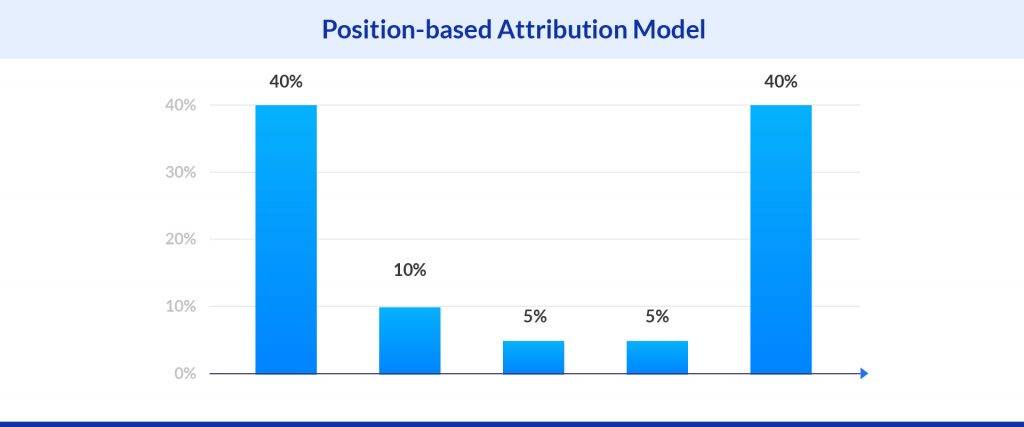
The position-based attribution model is a marketing strategy that assigns credit to touchpoints in the customer journey based on their position. The first and last interactions are given more weight, while the remaining credit is divided among the other touchpoints. This model is popular among advertisers as it provides an overview of the customer journey and recognizes the significance of the first and last interactions. It is an effective way for businesses to determine which marketing campaigns have the greatest impact on their customer’s decision-making process.
Using this method, businesses can optimize their marketing efforts and improve overall performance. However, implementing this method can be challenging and time-consuming due to its complexity, making it more suitable for certain types of businesses. Additionally, this model may not give enough credit to bottom-funnel efforts, making it more commonly used by marketing agencies that do not have sales teams responsible for generating awareness and leads for clients.
W-shaped attribution
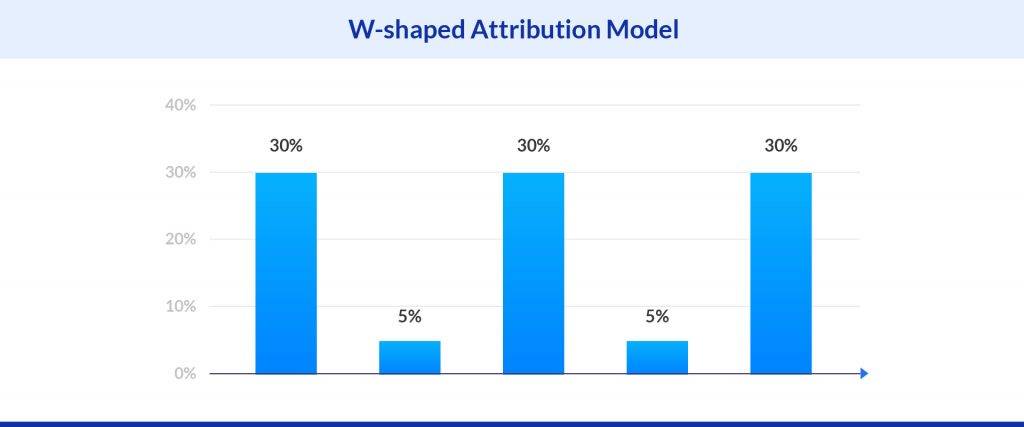
The W-shaped attribution model offers a granular approach to analyzing the effectiveness of different marketing channels at various stages of the customer journey. It recognizes the importance of initial engagement, nurturing, and opportunity creation in driving conversions.
However, its complexity may make it challenging to implement without a thorough understanding of the customer journey and the roles played by each touchpoint. For businesses seeking a more balanced perspective on their marketing efforts, the W-shaped model can provide valuable insights into how different channels work together to drive results.
Z-shaped attribution
The Z-shaped attribution model provides a comprehensive and holistic approach to giving credit throughout the customer journey. By equally distributing credit across four pivotal stages – first touch, lead conversion, opportunity creation, and customer close – businesses can gain a better understanding of the cumulative impact of various touch points on their success. This model is particularly beneficial for businesses seeking to fully understand and optimize each stage of the customer journey.
Custom attribution
Custom attribution models offer a flexible solution for businesses looking to accurately attribute credit across the customer journey. By allowing companies to define their own set of rules, these models can be tailored to fit the unique aspects of their campaigns, customer behaviors, and journey nuances. This adaptability ensures that businesses can accurately measure and optimize the effectiveness of their marketing efforts.
These models require a deep understanding of the customer journey and the ability to effectively translate this knowledge into attribution rules. It’s important to note that cross-device attribution is crucial for a complete understanding of how interactions occur across platforms and devices, as the aforementioned models typically focus on specific devices and browsers. This comprehensive approach ensures a thorough understanding of the customer journey.
How to choose the right attribution model?
Choosing the right attribution model sets the groundwork for measuring marketing effectiveness, understanding customer behavior, and optimizing ROI. With so many available models and a complex customer journey, it can be challenging to make this decision. However, by considering the key factors and asking the right questions, marketers can navigate through this complexity and choose an attribution model that aligns with their business goals and marketing strategies.
Ensure accurate ROI evaluation
Attribution consistency is essential for accurate ROI evaluation. By aligning attribution models and methodologies, marketers can get a comprehensive understanding of the customer journey, ensuring that each touchpoint receives proper credit. With this clarity, it becomes easier to identify high-impact channels and tactics, guiding marketers in optimizing their marketing spend to maximize ROI. Precisely attributing value across the customer journey is crucial for understanding the true impact of marketing efforts and making informed investment decisions.
Facilitate seamless collaboration
Collaboration is a must in the world of multi-channel retail. Brands, agencies, and retailers must work together to achieve the best results. A consistent approach to attribution helps facilitate this collaboration by providing a shared language and framework for evaluating campaign performance. This common ground ensures alignment in objectives and strategies, making marketing efforts more effective and strengthening partnerships between all involved parties.
Unlock data-driven insights
Implementing consistent attribution practices can provide valuable data-driven insights for marketers. By analyzing patterns, trends, and correlations across different channels and campaigns, they can gain actionable intelligence. This approach allows for identifying growth opportunities, refining strategies, and achieving better outcomes. It also ensures decisions are based on real data, providing a strong foundation for strategic planning and execution.
Tailor the attribution model to your business
When it comes to choosing an attribution model, there is no one-size-fits-all approach. It should be a carefully tailored process that takes into account the specific needs and goals of your business, as well as the unique interactions your customers have with your brand. Here are some key factors to consider when making your decision.
- Understanding the sales cycle: Examine the details of your typical sales cycle, including its duration and structure. Are there any offline conversions that should be taken into account? Understanding these dynamics can help choose a model that effectively represents the client’s journey.
- Identifying customer touchpoints: How do customers learn about your company? What channels are important in their journey? A thorough understanding of these touchpoints is required to choose an attribution model that involves every aspect of customer interactions.
- Analyzing drop-off and return points: Understanding when and why customers drop off during the buying journey is crucial for improving overall sales. By identifying these key stages, businesses can focus on specific areas for improvement and develop effective strategies for bringing customers back. This valuable insight can be used to select a model that accurately pinpoints these areas and guides customers toward re-engagement.
- Determining purchase triggers: What eventually motivates a consumer to buy? Understanding these triggers is important for choosing an attribution model that effectively allocates value to touchpoints before conversion.
Unlocking Advertising Success with FCC
With the vast and intricate world of marketing attribution, it’s essential to have a clear understanding of how it works to optimize your advertising efforts. Selecting the appropriate attribution model for your business can accurately assess the value of each customer touchpoint so that you can make informed decisions about where to allocate your marketing budget. This not only improves campaign performance but also ensures that resources are invested in channels that truly make a difference, resulting in higher ROI and sustainable growth.
FCC’s Ads Manager is designed to make retail advertising easier for marketers. Our user-friendly platform seamlessly integrates with your current marketing tools, allowing you to dive into performance analytics, effortlessly manage campaigns, and access advanced targeting options all in one place.
With FCC’s Ads Manager you can:
- Onboard Display Ads for instant revenue and add a quick revenue stream while increasing brand engagement on your platform
- Monetise online activity with sponsored listings. Advance to customer context-based ads and convert searches & browses to revenue even before checkouts.
- Get experts’ consult & implement high yielding ad revenue models.
- Build your own ads’ ecosystem at relatively fractional effort and investment.
Connect Flipkart Commerce Cloud today to explore how our Ads Manager can transform your advertising strategy, drive efficiency, and propel your business toward unprecedented success. Book a free consultation today!